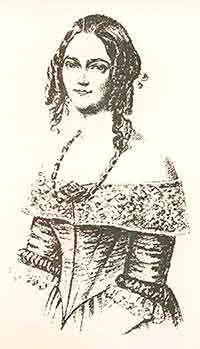Charlotta Djurström
| Charlotta Djurstrom | |
|---|---|
 | |
| Born |
Hedvig Charlotta Hoffman 14 May 1807 Kalmar, Sweden |
| Died |
19 May 1877 (aged 70) Norrköping, Sweden |
| Other names | Charlotta Hoffman |
| Spouse(s) | Erik Djurström |
Hedvig Charlotta Djurström, née Hoffman, (14 May 1807, Kalmar – 19 May 1877, Norrköping), was a Swedish actress. She was the most well known female country-side actors in Sweden in the first half of the 19th century, called "The Jeanne d'Arc of the Country-side" after her most famous part.
Biography
In the early 19th century, only the biggest cities in Sweden had real theatres; small towns and the countryside were visited by numerous travelling theatre-troupes, which performed in various localities in both Sweden and Finland. Charlotta Hoffman debuted in 1827 in the Stålberg company, which was one of the best-known of the companies touring the country-side. This company was soon to be known as the Djurström company. Hoffman was a great beauty with a good singing-voice and soon developed into the prima donna of the troupe. She married Erik Djurström, actor and the director of the company.
At the beginning used in soubrette- and boys breeches parts, she moved on to girl's- and heroine parts, in which she was to become most known. In 1832, she became the first Jeanne d'Arc in Orleanska Jungfrun ("The Maid of Lorriane") by Schiller on a Swedish stage, a part in which she was called "burningly tragic" and so famous that people came from the most isolated parts and villages to see her in the small towns she performed, after which she earned her nickname "The Jeanne d'Arc of the country-side". As a person, however, she was described by her colleagues as affected and plotting and very much a diva. The fame was reserved for the countryside, however; when the company performed in Stockholm in 1841, it was not given very good critic, and Charlotta Djurstrom was only considered as an averagely good actor within "lighter comedy".
After the death of her husband, Charlotta worked in the troupes of Ellfforss and Hessler and finally at the Ladugårdsland Theatre in Stockholm, where she was still considered as an ornament on the stage until her retirement in 1864. She spent her last years in Norrköping.
See also
References
- Georg Nordensvan: "Svensk teater och svenska skådespelare. Första bandet, 1773-1842" (Swedish theatre and Swedish actors from Gustav III to our days. First book 1772-1842) (Swedish)
- Europas konstnärer (The artists of Europe) (Swedish)